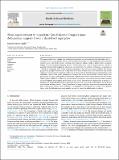Por favor, use este identificador para citar o enlazar a este item:
http://hdl.handle.net/10261/344630COMPARTIR / EXPORTAR:
 SHARE SHARE
 CORE
BASE CORE
BASE
|
|
| Visualizar otros formatos: MARC | Dublin Core | RDF | ORE | MODS | METS | DIDL | DATACITE | |

| Título: | From supercontinent to superplate: Late Paleozoic Pangea's inner deformation suggests it was a short-lived superplate |
Autor: | Pastor-Galán, Daniel | Palabras clave: | Orocline | Paleotethys | Pangea | Permian | Rheic | Supercontinent | Superplate | Fecha de publicación: | 1-mar-2022 | Editor: | Elsevier | Resumen: | The supercontinent cycle explains how landmasses amalgamate into supercontinents that dismember after a ~ 100 Myr tenure in a quasi-periodic manner. Supercontinents are thought to be rigid superplates whose formation controls many of the Earth's secular variations, from long-term climate trends to global mantle circulation. Pangea, the latest continental superplate, formed ~330 Ma, began to rift ~240 Ma, finally broke-up ~200 Ma, is generally considered the template for all previous supercontinents. The existence of Pangea as a superplate at ~330 Ma is inconsistent with: (i) the kinematic constraints of the continent-continent collision that became progressively younger westwards and it only ended in the early Permian times in its westernmost side; (ii) the widespread ‘post-orogenic’ magmatism in the core of Pangea and the hot high-pressure metamorphism in the Paleotethys; and (iii) the global paleomagnetic database that shows paleolatitudinal overlaps between the participating continents, and significant vertical axis rotations in the core of Pangea between 330 and 270 Ma, which suggests >1500 km of shortening and extension. Here I present a tectonic reconstruction that reconciles the paleomagnetic and geological discrepancies. In this model, after the initial amalgamation of Pangea as a landmass, the comprising plates kept on interacting between each other and the asthenosphere during the late Carboniferous and early Permian (320–270 Ma) instead of being a rigid plate. After that and concomitant with a plate reorganization, Pangea finally established as a superplate for a brief period of <70 Myr. This superplate tenure might be, following most recent models, too short to control the global mantle circulation. | URI: | http://hdl.handle.net/10261/344630 | DOI: | 10.1016/j.earscirev.2022.103918 | ISSN: | 00128252 |
| Aparece en las colecciones: | (IGEO) Artículos |
Ficheros en este ítem:
| Fichero | Descripción | Tamaño | Formato | |
|---|---|---|---|---|
| From supercontinent to superplate Late Paleozoic Pangea's.pdf | Articulo principal | 10,97 MB | Adobe PDF |  Visualizar/Abrir |
CORE Recommender
SCOPUSTM
Citations
7
checked on 25-abr-2024
WEB OF SCIENCETM
Citations
5
checked on 23-feb-2024
Page view(s)
13
checked on 30-abr-2024
Download(s)
5
checked on 30-abr-2024
Google ScholarTM
Check
Altmetric
Altmetric
Este item está licenciado bajo una Licencia Creative Commons

